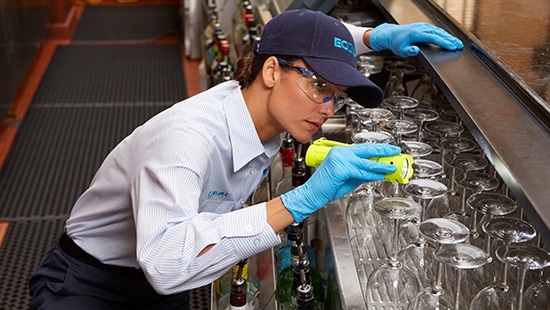Pest Control Services Near Me Chicago: Reliable Solutions for All Pests
Pest Control Services Near Me Chicago: Reliable Solutions for All Pests
Blog Article
A Comprehensive Guide to the Various Kinds of Insect Control Methods
With the myriad of parasite control approaches offered, it can be frustrating to discover the most efficient remedy for a particular pest issue. In this thorough guide, we will certainly discover these various kinds of parasite control approaches, using understandings right into their applications and benefits. By the end, you will certainly have a more clear understanding of which technique may be the finest fit for your parasite control requirements.
Chemical Parasite Control Approaches

One typical type of chemical pest control is pesticides. Pesticides target details insects, such as insects, termites, or ants, and can be made use of both inside your home and outdoors.
One more sort of chemical insect control is rodenticides. These are chemical substances designed to regulate populations of rodents, such as rats and mice. Rodenticides are usually utilized in lure form, which attracts the rodents and then kills them after consumption. They are typically made use of in agricultural settings, along with in property and business buildings (Customized pest control solutions Chicago).
Weed awesomes, likewise known as herbicides, are another kind of chemical insect control method. Herbicides are made to selectively kill undesirable plants, referred to as weeds, without causing injury to preferable plants. They are commonly used in farming, landscaping, and horticulture to regulate the growth of undesirable plants.
While chemical parasite control techniques can be very reliable in removing insects, it is essential to use them carefully and comply with safety standards. Overuse or abuse of chemical pesticides can have negative effect on human health and the environment. Consequently, it is critical to employ these methods responsibly and consider alternate bug control methods whenever possible.
Biological Parasite Control Approaches
Biological parasite control methods involve using living organisms or all-natural substances to handle and manage pest populations. Unlike chemical techniques, which usually count on synthetic pesticides, biological control methods make use of the all-natural adversaries of bugs to control their populaces. This strategy is considered even more eco pleasant and lasting, as it minimizes the use of damaging chemicals and minimizes the danger of chemical resistance.
One commonly used biological insect control method is the intro of all-natural predators or parasites. As an example, ladybugs are presented to manage aphids, while certain wasp varieties are launched to target caterpillars. These killers and parasites prey on bugs, minimizing their numbers and avoiding invasions.
One more biological control approach is using virus. Specific bacteria, infections, and fungi can be used to infect and kill specific bugs. For example, the microorganism Bacillus thuringiensis is frequently used to regulate caterpillars, as it creates toxic substances that are lethal to these insects.
Organic control techniques can additionally entail the usage of pheromones or all-natural materials that interrupt the breeding patterns of pests. By hindering their reproduction, these methods aid to decrease pest populaces over time.
While organic insect control approaches are generally efficient, they look at this site might require longer periods to accomplish desired outcomes contrasted to chemical methods. Furthermore, mindful factor to consider has to be provided to the choice and launch of all-natural enemies to stop unintended damage to beneficial organisms or ecological communities.
Physical Parasite Control Methods
To effectively take care of and regulate pest populations, alternative pest control techniques recognized as physical insect control approaches are utilized. Another physical bug control method is the installment of fences or wall surfaces to keep larger bugs, such as deer or rabbits, out of yards or farming fields. Physical parasite control methods are an environmentally friendly alternative to chemical pesticides, as they do not count on the use of dangerous chemicals.
Natural Bug Control Approaches
Natural bug control approaches provide a lasting and environment-friendly method to managing and getting rid of parasites. These methods prioritize using all-natural substances and biological representatives, reducing the requirement for chemical pesticides that can damage the environment and human health and wellness. Among the most usual all-natural pest control techniques is organic control. This entails presenting all-natural predators or parasites to exploit or parasitize the pests. For instance, ladybugs are usually presented to yards to manage aphid populaces. Another all-natural approach is the use of repellents stemmed from plants. Certain plants, such as marigolds, lavender, and peppermint, release fragrances that ward off parasites like insects, flies, and ants. Additionally, useful content social control practices can be employed to avoid and take care of parasite problems. This consists of correct sanitation, regular maintenance, and promoting biodiversity in the garden. For instance, turning plants, eliminating garden debris, and motivating all-natural killers can assist stop the buildup of parasites. By taking on these all-natural bug control methods, individuals and areas can properly take care of insects while minimizing the negative influence on the setting and human health and wellness.
Integrated Pest Monitoring (IPM)
Integrated Bug Monitoring (IPM) is an extensive and organized approach to pest control that integrates different approaches and techniques to efficiently handle pests while reducing using chemical pesticides. IPM aims to maintain insect populations below the financial injury degree by utilizing a combination of cultural, biological, and chemical control methods.
Cultural control approaches entail modifying the environment to make it less beneficial for insects. This can include practices such as crop turning, proper hygiene, and making use of immune plant varieties. By developing negative problems for pests, cultural control approaches can considerably minimize bug populaces.

Chemical control techniques are used as a last resource in IPM. They include the targeted and judicious use pesticides to handle bug populations. Unlike standard insect control approaches, IPM intends to decrease making use of chemical pesticides by employing different methods.
Integrated Pest Monitoring (IPM) is a proactive approach that concentrates on long-lasting parasite administration instead than relying exclusively on reactive actions. By integrating multiple control techniques, IPM gives a more sustainable and eco-friendly technique to pest control.
Verdict
It talked about chemical, biological, physical, and natural insect control techniques, as well as the incorporated pest monitoring approach. By understanding these different methods, individuals can make enlightened decisions on which bug control method is most suitable for their particular requirements and choices.
Report this page